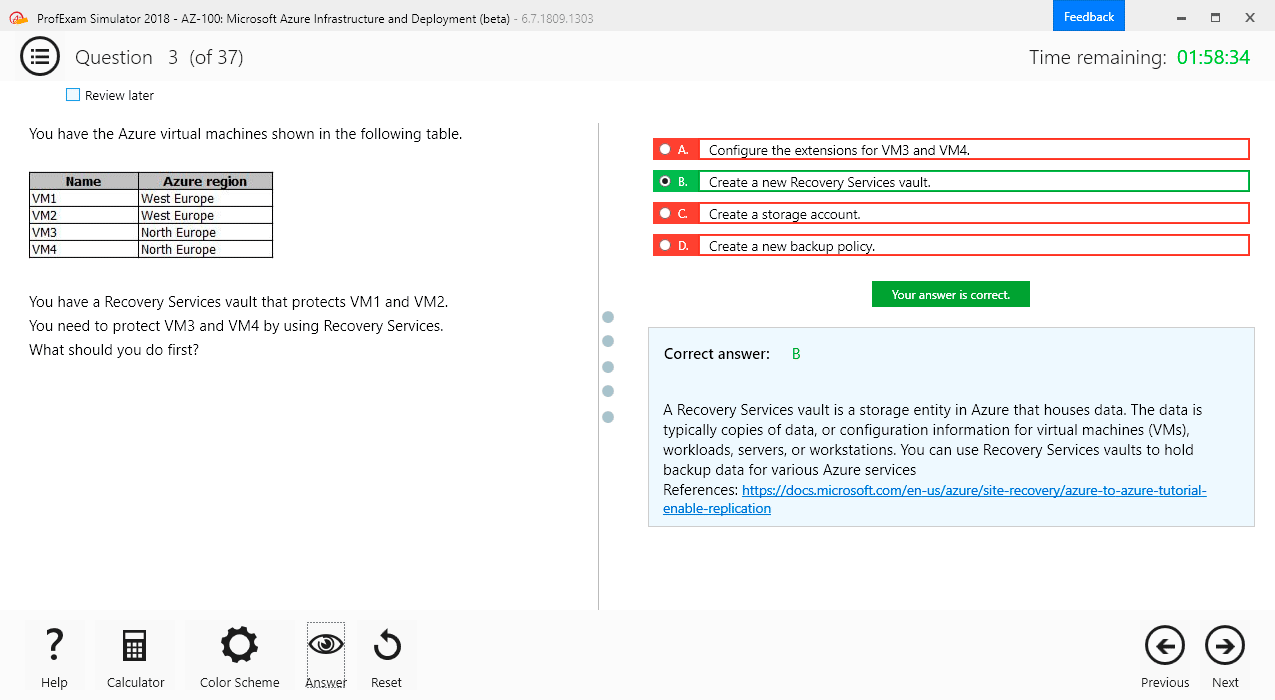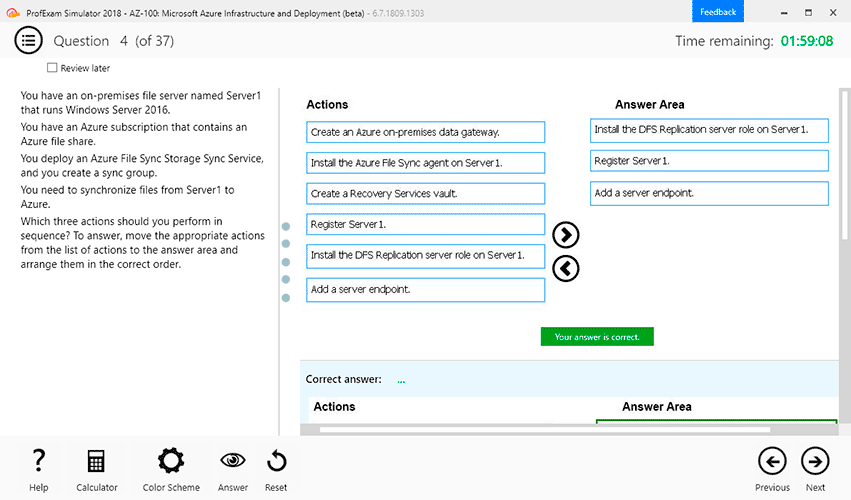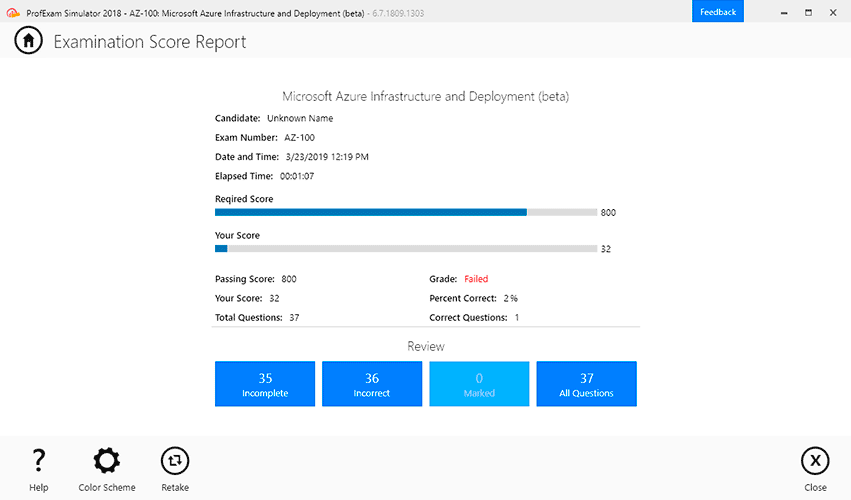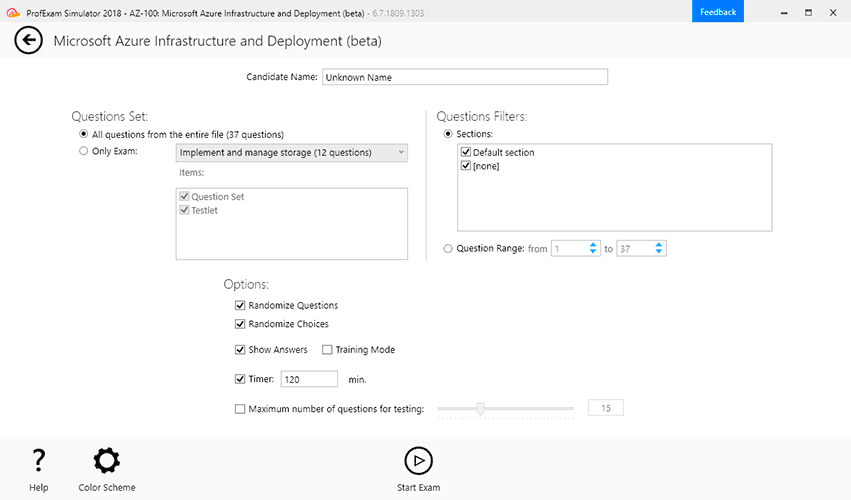File Info
| Exam | Professional Cloud Database Engineer |
| Number | Professional-Cloud-Database-Engineer |
| File Name | Google.Professional-Cloud-Database-Engineer.VCEplus.2024-08-18.92q.vcex |
| Size | 81 KB |
| Posted | Aug 18, 2024 |
| Download | Google.Professional-Cloud-Database-Engineer.VCEplus.2024-08-18.92q.vcex |
How to open VCEX & EXAM Files?
Files with VCEX & EXAM extensions can be opened by ProfExam Simulator.
Coupon: MASTEREXAM
With discount: 20%






Demo Questions
Question 1
You are setting up a Bare Metal Solution environment. You need to update the operating system to the latest version. You need to connect the Bare Metal Solution environment to the internet so you can receive software updates. What should you do?
- Setup a static external IP address in your VPC network.
- Set up bring your own IP (BYOIP) in your VPC.
- Set up a Cloud NAT gateway on the Compute Engine VM.
- Set up Cloud NAT service.
Correct answer: C
Explanation:
https://cloud.google.com/bare-metal/docs/bms-setup?hl=en#bms-access-internet-vm-natThe docs specifically says 'Setting up a NAT gateway on a Compute Engine VM' is the way to give BMS internet access. https://cloud.google.com/bare-metal/docs/bms-setup?hl=en#bms-access-internet-vm-natThe docs specifically says 'Setting up a NAT gateway on a Compute Engine VM' is the way to give BMS internet access.
Question 2
You are troubleshooting a connection issue with a newly deployed Cloud SQL instance on Google Cloud. While investigating the Cloud SQL Proxy logs, you see the message Error 403: Access Not Configured. What should you do?
- Check the app.yaml value cloud_sql_instances for a misspelled or incorrect instance connection name.
- Check whether your service account has cloudsql.instances.connect permission.
- Enable the Cloud SQL Admin API.
- Ensure that you are using an external (public) IP address interface.
Correct answer: C
Explanation:
https://cloud.google.com/sql/docs/mysql/connect-auth-proxy#troubleshootingC because in docs it says 'Make sure to enable the Cloud SQL Admin API. If it is not, you see output like Error 403: Access Not Configured in your Cloud SQL https://cloud.google.com/sql/docs/mysql/connect-auth-proxy#troubleshootingC because in docs it says 'Make sure to enable the Cloud SQL Admin API. If it is not, you see output like Error 403: Access Not Configured in your Cloud SQL
Question 3
You are working on a new centralized inventory management system to track items available in 200 stores, which each have 500 GB of data. You are planning a gradual rollout of the system to a few stores each week. You need to design an SQL database architecture that minimizes costs and user disruption during each regional rollout and can scale up or down on nights and holidays. What should you do?
- Use Oracle Real Application Cluster (RAC) databases on Bare Metal Solution for Oracle.
- Use sharded Cloud SQL instances with one or more stores per database instance.
- Use a Biglable cluster with autoscaling.
- Use Cloud Spanner with a custom autoscaling solution.
Correct answer: D
Explanation:
https://cloud.google.com/spanner/docs/autoscaling-overview1. CloudSQL max out at 64TB, so unable to told 100TB of data. https://cloud.google.com/sql/docs/quotas#metrics_collection_limit2. Scale is done manually on SQL Cloud https://cloud.google.com/spanner/docs/autoscaling-overview
1. CloudSQL max out at 64TB, so unable to told 100TB of data. https://cloud.google.com/sql/docs/quotas#metrics_collection_limit2. Scale is done manually on SQL Cloud
Question 4
Your organization has strict policies on tracking rollouts to production and periodically shares this information with external auditors to meet compliance requirements. You need to enable auditing on several Cloud Spanner databases. What should you do?
- Use replication to roll out changes to higher environments.
- Use backup and restore to roll out changes to higher environments.
- Use Liquibase to roll out changes to higher environments.
- Manually capture detailed DBA audit logs when changes are rolled out to higher environments.
Correct answer: C
Explanation:
To satisfy audit reporting you would need a way to record what was changed and when. The best answer is one which uses some kind of source code control system (SCCS). That rules out A and B. Any mention of anything manual in a cloud environment should look suspicious, which leave option C. As it happens, Liquibase is an SCCS and can be integrated with Spanner. https://cloud.google.com/spanner/docs/use-liquibase To satisfy audit reporting you would need a way to record what was changed and when. The best answer is one which uses some kind of source code control system (SCCS). That rules out A and B. Any mention of anything manual in a cloud environment should look suspicious, which leave option C. As it happens, Liquibase is an SCCS and can be integrated with Spanner. https://cloud.google.com/spanner/docs/use-liquibase
Question 5
Your organization has a production Cloud SQL for MySQL instance. Your instance is configured with 16 vCPUs and 104 GB of RAM that is running between 90% and 100% CPU utilization for most of the day. You need to scale up the database and add vCPUs with minimal interruption and effort. What should you do?
- Issue a gcloud sql instances patch command to increase the number of vCPUs.
- Update a MySQL database flag to increase the number of vCPUs.
- Issue a gcloud compute instances update command to increase the number of vCPUs.
- Back up the database, create an instance with additional vCPUs, and restore the database.
Correct answer: A
Explanation:
https://cloud.google.com/sdk/gcloud/reference/sql/instances/patch https://cloud.google.com/sdk/gcloud/reference/sql/instances/patch
Question 6
You are configuring a brand new Cloud SQL for PostgreSQL database instance in Google Cloud. Your application team wants you to deploy one primary instance, one standby instance, and one read replica instance. You need to ensure that you are following Google-recommended practices for high availability. What should you do?
- Configure the primary instance in zone A, the standby instance in zone C, and the read replica in zone B, all in the same region.
- Configure the primary and standby instances in zone A and the read replica in zone B, all in the same region.
- Configure the primary instance in one region, the standby instance in a second region, and the read replica in a third region.
- Configure the primary, standby, and read replica instances in zone A, all in the same region.
Correct answer: A
Explanation:
https://cloud.google.com/sql/docs/postgres/high-availability#failover-overview https://cloud.google.com/sql/docs/postgres/high-availability#failover-overview
Question 7
You are running a transactional application on Cloud SQL for PostgreSQL in Google Cloud. The database is running in a high availability configuration within one region. You have encountered issues with data and want to restore to the last known pristine version of the database. What should you do?
- Create a clone database from a read replica database, and restore the clone in the same region.
- Create a clone database from a read replica database, and restore the clone into a different zone.
- Use the Cloud SQL point-in-time recovery (PITR) feature. Restore the copy from two hours ago to a new database instance.
- Use the Cloud SQL database import feature. Import last week's dump file from Cloud Storage.
Correct answer: C
Explanation:
Using import/export from last week is slow for large scale databases and will restore database from last week. Using import/export from last week is slow for large scale databases and will restore database from last week.
Question 8
Your organization is running a MySQL workload in Cloud SQL. Suddenly you see a degradation in database performance. You need to identify the root cause of the performance degradation. What should you do?
- Use Logs Explorer to analyze log data.
- Use Cloud Monitoring to monitor CPU, memory, and storage utilization metrics.
- Use Error Reporting to count, analyze, and aggregate the data.
- Use Cloud Debugger to inspect the state of an application.
Correct answer: B
Explanation:
https://cloud.google.com/sql/docs/mysql/diagnoseissues#:~:text=If%20your%20instance%20stops%20responding%20to%20connections%20or%20performance%20is%20degraded%2C%20make%20sure%20it%20conforms%20to%20the%20Operational%20Guidelines https://cloud.google.com/sql/docs/mysql/diagnoseissues#:~:text=If%20your%20instance%20stops%20responding%20to%20connections%20or%20performance%20is%20degraded%2C%20make%20sure%20it%20conforms%20to%20the%20Operational%20Guidelines
Question 9
You work for a large retail and ecommerce company that is starting to extend their business globally. Your company plans to migrate to Google Cloud. You want to use platforms that will scale easily, handle transactions with the least amount of latency, and provide a reliable customer experience. You need a storage layer for sales transactions and current inventory levels. You want to retain the same relational schema that your existing platform uses. What should you do?
- Store your data in Firestore in a multi-region location, and place your compute resources in one of the constituent regions.
- Deploy Cloud Spanner using a multi-region instance, and place your compute resources close to the default leader region.
- Build an in-memory cache in Memorystore, and deploy to the specific geographic regions where your application resides.
- Deploy a Bigtable instance with a cluster in one region and a replica cluster in another geographic region.
Correct answer: B
Question 10
You host an application in Google Cloud. The application is located in a single region and uses Cloud SQL for transactional data. Most of your users are located in the same time zone and expect the application to be available 7 days a week, from 6 AM to 10 PM. You want to ensure regular maintenance updates to your Cloud SQL instance without creating downtime for your users. What should you do?
- Configure a maintenance window during a period when no users will be on the system. Control the order of update by setting non-production instances to earlier and production instances to later.
- Create your database with one primary node and one read replica in the region.
- Enable maintenance notifications for users, and reschedule maintenance activities to a specific time after notifications have been sent.
- Configure your Cloud SQL instance with high availability enabled.
Correct answer: A
Explanation:
Configure a maintenance window during a period when no users will be on the system. Control the order of update by setting non-production instances to earlier and production instances to later. Configure a maintenance window during a period when no users will be on the system. Control the order of update by setting non-production instances to earlier and production instances to later.

